This week at Tate Britain, we focused on Pre-Raphaelite art and the development of each of the artists. The Pre-Rapaelite Brotherhood was a secret society of artists who worked to defy classical Renaissance styles being taught at the Royal Academy School. The PRB focused on showcasing even the smallest details in a painting, whether it be the petal of a flower and someone’s eyelash. The amount of detail used was so groundbreaking that their was accused of being photographs rather than paintings. Millais, Hunt, Rossetti, and Brown were all members of this society, and their art proves to be perfect examples of Pre-Raphaelite styles.
1. Sir John Everett Millais– Born to a wealthy family in Southampton, Millais was considered a child art prodigy from when he was nine years old. He was admitted to the Royal Academy School as the youngest student ever, where he received gold and silver awards for his painting The Tribe of Benjamin Seizing the Daughters of Shiloh and a drawing of the antique, respectively. While studying at the Royal Academy, Millais became friends with William Holman Hunt and Dante Gabriel Rossetti. It was these three young artists who decided to start the Pre-Raphaelite Brotherhood. Millais’ PRB painting Christ in the House of His Parents was not received very well due to it’s then unusual style. The painting features a huge amount of balance, shown in the characters that balance three on each side, almost exactly evenly spaced. Then there is the lines depicted all over the place in the painting. For example there are horizontals made by the table and steps on the ladder, verticals from the doorframe and table legs, and diagonals from the planks of wood in the background. Viewers of the time did not enjoy that the holy family was depicted so lowly, yet at the same time we see Joseph and Mary wearing red and blue which are often seen as colors of royalty. Also the complimentary colors of green and orange are used next here in the other woman’s clothing. there is huge amounts of detail in the facial expressions, hands, wood shavings, etc.
Ophelia was an iconic painting of the time, due in part to its reference to Shakespeare’s Hamlet, but also because of the huge amount of Millais’ talent that it displayed. Once again we see repeating themes of detail and lines. Detail is in every part of this painting, in every flower, shrub, and fold of her clothing. There are lots of horizontals, most notably the ones the sides of the river make and the branches hovering above her. The painting has an entirely three dimensional feel. You can literally see due to the darkness of the water and the colors of her dress, where the water gets deeper and how deep Ophelia rests within it. The reeds in the left foreground of the painting along with the trees behind them create a “curtain” for the piece, implying that woods continue to the left, making the scene more realistic. Millais creates a golden section with Ophelia’s body, having 3/8 to the right of her body and 5/8 to the left.
Fun fact: The model for Ophelia was Elizabeth Siddal, Rossetti’s wife.
2. William Holman Hunt– Unlike Millais, Hunt was not born to a wealthy family, nor was he a child prodigy. Hunt worked as an office clerk before being accepted into the Royal Academy School, though he was rejected the first time he applied. The Pre-Raphaelite Brotherhood’s goal was to capture the beauty of the natural world in a religious devotion to truth. This goal was especially important to Hunt as he was a very religiously devoted man. Initially, Hunt’s work was not received very well. His art was allegedly clumsy. Yet Hunt’s attention to detail and use of vibrant colours makes his painting’s very notable.
The Awakening Conscience showcases a mistress in the hands of her lover just as she begins to have a revelation. Hunt makes it clear that she is a mistress due to her lack of wedding ring. He also includes many symbols that tell the story of this mistress and the situation she is in. The reflection in the mirror behind her of the sunlit garden represents her lost innocence, though the possibility of reception is indicated by the rays of sun. The tangled yarn in the bottom right corner of the painting symbolises the web that entraps the mistress. Under the table is a cat that has captured a bird, symbolising the unfortunate and difficult situation that the mistress is in. The frame around the painting in Tate Britain (not pictured) is detailed with symbols as well, such as stars that represent the girl’s spiritual revelation.
Intense detail can be seen in the bottom hem of the girl’s dress and in the couple’s facial features, especially the gentleman’s eyelashes. What makes this painting stand out the most is Hunt’s use of extremely vibrant colours. The bright red used in the carpet, the gold used in the mirror’s reflection, and the vivid patterns of reds, greens, blues, and yellows in the mistress’ shawl make this painting stand out against the others.
3. Dante Gabriel Rossetti– Rossetti came onto the art scene in the late 1840’s to early 1850’s. He began with a more traditional style, choosing subjects that were more religious in subject matter, such as in his work “Girlhood of Mary Virgin”. After marrying the beautiful Elizabeth Siddal, he had gained a new muse and perspective on painting that gradually developed and changed as he emerged into the true pre-Raphaelite style through and through.
In Rosetti’s “The Beloved”, we see a close up of 6 women, assumed to be at a wedding for the center woman. each woman is displayed with complete beauty and detail though and it is to be noted that no scenery can be scene around or beyond them, with the focus remaining strictly on them. The center woman, the bride, bears an uncanny resemblance to women from other Rossetti paintings due to her likeness to his wife. Rossetti toys with the idea of fantasy, showing an extravagant event that could be set in an unseen tropical place or somewhere exotic. This plays into a viewer’s desire for something out of the ordinary and fantastic. The painting is almost photographic, with its complete balance on either side of the woman and frame of faces and flowers.
One of Rossetti’s other works, “Beata Beatrix”, is even more interesting. It shows a woman that could represent the deaths of both his beloved Beatrice or his wife Elizabeth. the painting is full of symbolism, with the bird bringing peacefulness, the time dial with the sun setting upon it showing the time remaining of life, and the figures in the back representing his love and her death. The perfect use of light to capture the woman’s serene face and the distance behind her illuminates the beauty of the work itself.
4. Ford Madox Brown– Brown was not one of the original founding members of the Pre-Raphaelite Brotherhood. Though he is not entirely similar to the other three artists featured, he still uses similar techniques. For example, Brown’s detail is not as intense or defined as the other artists, but he is similar in the fact that he chooses bright and vivid colours. This can be seen in his painting The Hayfield.
Though the details in this painting are not as specific as those in Mallais or Hunt’s work, it is still more detailed than typical Renaissance paintings that were being created during this time period. For example, individual branches can be seen the trees despite their small size. Overall, our personal opinion is that this painting is not as impressive as works created by other members of the PRB.

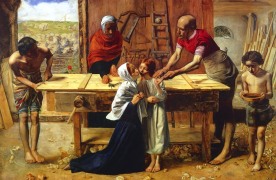
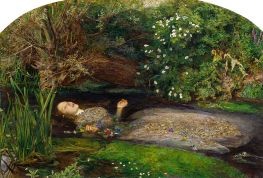
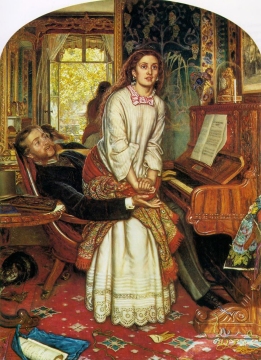
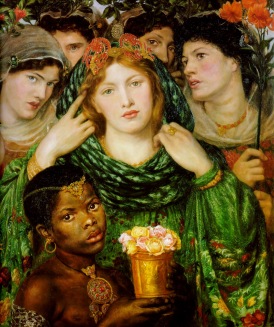
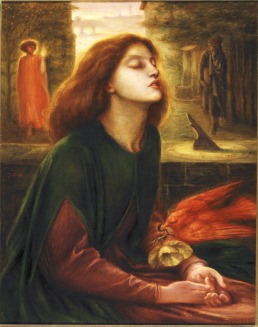

Reblogged this on NUartinlondon.
LikeLike